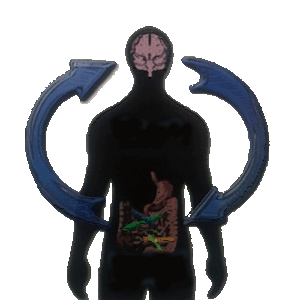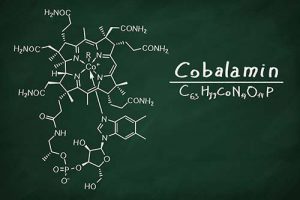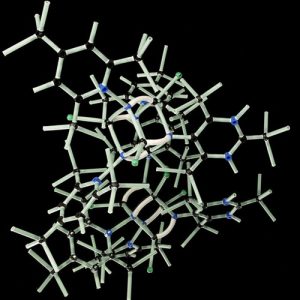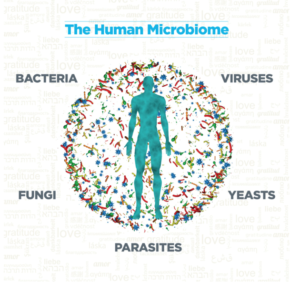 Our gut is a central organism in our body, and it includes the oesophagus, stomach, and intestines. All these parts work together so we can both eat and digest our food. The main function of the gut is to keep the system functional and balanced.
Our gut is a central organism in our body, and it includes the oesophagus, stomach, and intestines. All these parts work together so we can both eat and digest our food. The main function of the gut is to keep the system functional and balanced.
Gut health is essential for
- our immune system,
- absorption of nutrients,
- creation of some nutrients via gut bacteria
- and gut/brain connection
As it turns out our gut plays a key role in methylation and poor gut health can derail methylation.
How Does Methylation Affect Gut Health?
Firstly what is methylation again?
Methylation helps embryos first develop and grow and then assists in gene expression, nutrient conversion and many other bodily processes.
Methylation supports functions of the cardiovascular, detoxification and neurological systems, just to name a few. You can see why it’s important to support normal methylation, including to prevent certain symptoms and diseases from developing.
Our body needs certain enzymes and nutrients, especially folate and B vitamins, to carry out the methylation cycle. Oxidative stress and inflammation (which leads to leaky gut) are capable of interfering with the process. This means that a healthy diet and lifestyle are both key for optimizing methylation.
What is Leaky Gut?
We have blogs on leaky gut as well however in summary: Leaky gut occurs when the intestinal lining gets damaged. The digested food and microbial flora that are meant to be confined to the gut don’t stay in the gut but ‘leak out’ and create an immune response. We might see this with a high Zonulin reading in your stool test for example. The condition is also known as intestinal permeability. This results in the inflammation and may cause inflammation throughout the body, because toxins pass through the gut wall and enter the bloodstream when they shouldn’t be able to. This can affect your immune system and cell membranes which can lead to further health issues.
Causes of Leaky Gut
There are several different factors that can contribute to leaky gut:
- Imbalanced gut bacteria
- Stress
- Pesticides
- Food allergens
These factors place stress on the digestive systems.
So how is this all linked to methylation?
We have talked about methylation in other blogs, please see the end of this blog for further reading. In summary methylation is a simple biochemical process, which is essential to our overall well-being. When it is out of balance, it can cause several different health problems. Methylation is where a molecule called a ‘methyl group’ is added to another substance, such as DNA or a protein, so this substance can function and go about its duties.
The symptoms of MTHFR mutations are, to say the least very complicated health effects. Because MTHFR variants don’t just cause a problem with folate metabolism. But also this causes several major problems that all have their own set of symptoms. Over 50% of society has some form of the MTHFR mutation such as the two mthfr c677t and a1298c genes that have serious consequences for a persons health and wellness.
What Does the Term ‘Methyl’ Mean?
“Methyl” refers to nutrients that are involved in a biochemical process called methylation. During methylation, a process that is critical for healthy bodily functioning, chemicals are added to and bond with proteins, DNA, or other molecules. Methyl donors are composed of a carbon atom attached to three hydrogen atoms, signified as CH3.
Although experts have not yet completely identified how methylation works, it is known that it is intimately involved in the metabolism of DNA and lipids and appears to help prevent the expression of cancer genes and thus the development of cancer. In fact, methyl-related nutrients have been associated with a reduced risk of pancreatic, colon, and breast cancers.
Signs of Malfunctioning Methylation Can Include:
(This could be due to insufficient methyl groups or an inability to use the methyl groups you have).
- Low energy levels
- Digestive problems
- Histamine intolerance
- Changes in cholesterol levels
- Hormone imbalance
- Depression
- Anxiety
- Migraines and headaches
- Poor detox capabilities
- Multiple chemical sensitivity
- Cancer
- Infertility
- Multiple miscarriage
- Chronic Fatigue
- ADD/ADHD
- Birth defects
- Potentially higher risk for certain diseases, including ADHD, Alzheimer’s, atherosclerosis, diabetes and autoimmune disorders.
And much more.
Methylation also allows the body to make a number of other important molecules, including:
- Melatonin, which helps with sleep
- Serotonin, which regulates mood, appetite and more
- Norepinephrine, which is involved in arousal and motivation
- Glutathione, often called the body’s “master antioxidant” that fights free radicals
- Coenzyme Q10, an antioxidant involved in energy production and healthy aging
- Nitric oxide, which facilitates vacillation of blood vessels and circulation
- L-carnitine, an amino acid that supports metabolic processes and cellular energy
- Cysteine, an amino acid that helps make protein and form collagen in the body
- Creatine, needed for skeletal and muscle function
- Taurine, an amino acid that supports the heart, nerves and brain
As I keep saying in all these blogs – methylation is a big deal!
Are you eating Methyl Donor Foods?
It’s suspected that the ability of the body to perform methylation declines with age, which means eating plenty of methyl donor foods could be beneficial in helping prevent diseases such as Alzheimer’s and heart disease. Methyl donors also assist in the production of several brain chemicals (e.g., dopamine, epinephrine) that are involved in energy, alertness, concentration, mood, and visual clarity. These, subsequently, are important to manage in order to avoid depression and dementia.
Methyl donor foods contain nutrients such as:
- Vitamin B6
- Vitamin B12
- Folate (vitamin B9)
- Choline
- Methionine (an essential amino acid that is used in the production of proteins)
- Magnesium, zinc and protein (which is high in glutathione precursors) can also help support methylation.
Other nutrients involved in methylation include:
- N-dimethyl glycine (DMG),
- S-adenosylmethionine (SAM-e)
- Dimethyl-amino-ethanol (DMAE)
- DAO (diamine oxidase)
I’ll outline which foods are high in the above methyl donors in a moment.
For further explanation on the cycles of methylation and to help identify where your methylation (or the creation of these enzymes) may be off – please see our previous blogs.
Methylation and Leaky Gut
Proper methylation plays a key role in keeping the body functioning well. If you are suffering from a leaky gut, it’s important to improve the function of the gut, the quality of the mucosa and eliminate any dysbiotic bacteria. This helps heal the gut so you can move into the recovery phase. Each of the following nutrients will help improve methylation, and in return, improve gut health specifically:
- S-adenosyl-L-methionine (SAMe)
- Magnesium
- Riboflavin 5’-Phosphate (active vitamin B2)
- Pyridoxal 5’-Phosphate (active vitamin B6)
- 5-MTHF (active folate/vitamin B9)
- Methylcobalamin (active vitamin B12)
- Betaine (also known as trimethylglycine)
SAMe, the Gut, Food Allergies, Hives and Histamine.
S-adenosyl-L-methionine (SAMe) is a compound found naturally in the body. SAMe helps produce and regulate hormones and maintain cell membranes.
Methylation can affect SAMe’s production and cause intestinal problems. This can result in:
- Inability to digest food
- Nausea, vomiting and diarrhoea
- Decreased memory
- Bloating
- Headaches
- Mood fluctuations
- Joint and muscle pain
- Autoimmune diseases
A severe deficiency of SAM can lead to histamine intolerance, which results in food allergies, hives, skin conditions like eczema, anxiety, period pain, PMS, asthma and much more.
SAM is required for the breakdown of histamine, so when SAM is in short supply, the histamine isn’t broken down, leaving extra amounts in the body. This creates histamine intolerance.
Folate And The Gut.
Folate is vitamin B9, which is needed to make DNA and other genetic material. Bacteria play a key role in the production of folates in the colon region. If this bacteria is lacking in the body, then the folate isn’t received and it can result in conditions such as anaemia, slowed growth, neural tube defects, weight loss, diarrhoea, cancers and neurological issues like anxiety and depression. Monoglutamylated folate is produced in the gut region at a high rate. The intestinal microbes synthesize the folates and absorb it into the bloodstream where it is used in the body.
Absorption of Folate – The absorption of folate occurs first in the duodenum (the first and shortest section of the small intestine), then in the jejunum region (the larger part of the small intestine), and in the end, it reaches the colon. If gut health is poor, chances are there will be a lack of the folates in the body. If there is inflammation present or a person is suffering from diseases, such as colon cancer, then a reduction of folate will occur.
 The Importance Of Vitamin B12 For Methylation.
The Importance Of Vitamin B12 For Methylation.
The human body does not synthesize vitamin B12, yet it’s needed for different body functions, including gut health. Also known as cobalamin, vitamin B12 deficiency is more often seen in vegetarians, as the vitamin is mainly present in: liver, fish, eggs, chicken.
Role of Vitamin B12 (Cobalamin)
Cobalamin plays an active role in:
- synthesizing DNA and maintaining the health of blood cells and neurons
- also plays a major role in synthesizing gut bacteria that help in the digestion of the protein, as well as maintaining the health of the gut.
The intricate vitamin has a complex structure. It requires 30 different genes in a bacterial genome to make vitamin B12. Here is a list of our gut bacteria that produce vitamin B12:
- Firmicutes: Clostridium difficile, Faecalibacterium prausnitzii, Ruminococcus lactaris, Lactobacillus plantarum, L. coryniformis, and L. reuteri.
- Fusobacteria: Fusobacterium varium.
- Bacteroidetes: Bacteroides fragilis and Prevotella copri.
- Actinobacteria: Bifidobacterium animalis, B. infantis and B.longum.
These bacteria are present in the large intestine region, while the receptor of vitamin B12 is present in the small intestine. They absorb it after protein digestion in the stomach.
 Deficiency of Cobalamin – A deficiency can lead to several symptoms, such as anaemia, nausea, vomiting, diarrhoea, weight loss, sometimes constipation, memory problems and depression. If left untreated, it can also lead to death. Researchers have also found that deficiency of cobalamin can result in neurologic disorders.
Deficiency of Cobalamin – A deficiency can lead to several symptoms, such as anaemia, nausea, vomiting, diarrhoea, weight loss, sometimes constipation, memory problems and depression. If left untreated, it can also lead to death. Researchers have also found that deficiency of cobalamin can result in neurologic disorders.
Knowing this, it is important ensure your levels of vitamin B12 are healthy. Start by eating foods that are rich in cobalamin and take vitamins on top to supplement and maintain gut health.
Let’s discuss good sources of methyl donors and foods you may wish to avoid.
Good Methyl Donor Foods;
- Liver contains vitamin A, all the B vitamins, vitamins D and E, iron, copper, selenium, and zinc.
The liver does not filter toxins, Instead, the liver modifies them (phase 1 and 2 detoxification) to make them less toxic, and to make them easier to excrete (phase 3-transport). This leads to their elimination in the faeces and urine, not their retention in the liver.
Lamb’s liver has the highest level of vitamin B9/folate followed by beef liver, lamb shoulder and lamb shank.
Folate, like other B vitamins, is water-soluble, meaning that, rather than storing it, your body excretes any excess through your urine. Since your body doesn’t store it, you need to make sure you’re getting enough every day. The daily recommended intake of folate for teens and adults is 400mcg. Pregnant women need at least 600mcg per day, and breastfeeding women need 500mcg. Insufficient folate intake can lead to a deficiency. Too little of the vitamin can lead to megaloblastic anaemia, which has symptoms such as: fatigue, difficulty concentrating, heart palpitations, changes in your hair, nails, and skin.
Other good sources of vitamin B9/folate include: chickpeas, lentils, pinto beans, leafy greens (e.g., spinach, kale, collards, mustard greens, bok choy), strawberries, and citrus (e.g., grapefruit, oranges, lemons)
- Kidney contains the enzyme called DAO (diamine oxidase) mentioned earlier and shines in its ability to support the breakdown of histamine.
When we have poor methylation histamine becomes a problem. If DAO is inhibited, histamine will accumulate in the blood, leading to an array of symptoms. DAO is an enzyme that is dependent on B-vitamins, Vitamin C and Copper. Copper is the central atom of DAO and thus essential for its function of metabolism, oxidation, and inactivation of histamine.
Stay with me now.
Copper itself tends be useless in the body UNLESS it is loaded into the Ceruloplasmin (bio-available copper) protein by retinol (Vitamin A) NOW the copper can be utilised. Essentially Vitamin A is the missing piece to allow us to utilise bio-available copper which expresses DAO to neutralise histamine thus supporting methylation. Top sources of copper are shellfish especially oysters, shrimp, lobsters, clams and then liver.
Interestingly a lack of copper causes the body to retain excess iron. Contrary to many iron myths – excess iron is problematic and can create inflammation and gut issues. Is anaemia resolved by common place iron infusions? requires a large discussion. Needless to say copper can help reduce the effects of too much iron in the body and supports methylation.
So make sure you’re eating not only liver (homemade pate is the easiest way) but kidney and oysters! I throw some kidney into my pate as well. Make sure you see my recipe in the Well Adjusted Families App.
- Beef is a great source of many essential vitamins, minerals, and other nutrients
Including: vitamin B6, vitamin B12, vitamin D, thiamine, riboflavin, niacin, pantothenic acid, iron, zinc, magnesium, selenium, phosphorus, copper, calcium, and potassium. There are also other beneficial bioactive compounds in beef like taurine, carnitine, conjugated linoleic acid, endogenous antioxidants (ubiquinone, glutathione, lipoic acid, spermine, carnosine, anserine), and creatine.
- DMAE is naturally produced in the body. It’s also found in fatty fish, such as salmon, sardines, and anchovies.
- Vitamin B6: In addition to beef and liver – pistachios, pinto beans, avocado, blackstrap molasses, tuna, sunflower seeds, sesame seeds are good sources of vitamin B6.
- Vitamin B12: is found in fish, organic meats, seaweed (laver and nori), eggs.
- Methionine: can be found in Brazil nuts, sesame seeds, roasted soybeans, parmesan cheese, tuna, eggs, and white beans.
- Choline: eggs, liver, Brussel sprouts, broccoli, raw cauliflower, cooked beet greens, cooked asparagus.
- DMG: is found in beans, brown rice, pumpkin seeds.
Key Genes That Affect Our Microbiome
The body’s microbiome, composed of microbial cells that number in the trillions, is involved in human health and disease in ways that are just starting to emerge. The microbiome is assembled at birth, develops with its host, and is greatly influenced by environmental factors such as diet and other exposures. Recently, a role for human genetic variation has emerged as also influential in accounting for interpersonal differences in microbiomes. Thus, human genes may influence health directly or by promoting a beneficial microbiome. Studies of the heritability of gut microbiotas reveal a subset of microbes whose abundances are partly genetically determined by the host.
As we have seen, the microbiome shapes human health and protects us from disease. Recent studies suggest that variations in human genetics are also pivotal in the microbiome. Several studies show a clear relationship between microbial genes and human genes. For example, there is one notable bacteria, called bifido bacteria, which are related to the human lactase nonpersister genotype that leads to intolerance of lactose. Which gives weight to making sure that if you have symptoms of poor methylation or you have SNPs, that you focus on strong gut health.
 Here are some other genes that affect our microbiome:
Here are some other genes that affect our microbiome:
Hydrochloric acid – BHMT or betaine homocysteine methyltransferase is a zinc dependant enzyme that is highly expressed in the liver, kidney, and lens of the eye. This gene is used to catalyse the transfer of methyl from betaine to homocysteine. The result is the production of dimethylglycine and methionine.
The process of remethylation is critical for the synthesis of S-adenosyl methionine (SAMe), the methyl donor for most methylation reactions. This gene is essential in helping you to recycle homocysteine and from a clinical perspective people with this polymorphism do really well on betaine hydrochloride which is essential for absorption of nutrients.
If you’re considering adding a betaine HCL supplement to your regimen, make sure to talk to your healthcare provider and pharmacist before you make a big purchase. With their help, you can make an educated decision considering any potential risks or medication interactions based on your personal medical history.
Which foods contain betaine?
Here are 12 of the best food sources of betaine:
- Wheat Bran — 1/4 cup uncooked (about 15 grams): 200 mg
- Quinoa — About 1 cup cooked or 1/4 cup uncooked: 178 mg
- Beets — 1 cup raw: 175 mg
- Spinach — 1 cup cooked: 160 mg
- Amaranth Grain — About 1 cup cooked or 1/2 cup uncooked: 130 mg
- Rye Grain — About 1 cup cooked or 1/2 cup uncooked: 123 mg
- Kamut Wheat Grain — About 1 cup cooked or 1/2 cup uncooked: 105 mg
- Bulgar Grain — About 1 cup cooked or 1/2 cup uncooked: 76 mg
- Sweet Potato — 1 medium potato: 39 mg
- Turkey Breast — 1 breast cooked: 30 mg
- Veal — 3 ounces: 29 mg
- Beef — 3 ounces cooked: 28 mg
Foods To Be Mindful Of;
What many people won’t tell you is that there are some foods, even those considered healthy, that can be especially bad for those who have MTHFR and poor methylation. If your methylation is poor due to low MTHFR enzyme, the last thing you need is to be eating foods that cause methylation to speed up leading you to burn out of your essential nutrients quicker than normal. If you have recently taken the mthfr gene mutation test and found that your having trouble with methylation, staying away from the following foods can be a big help at least until you doing a lot better.
According to MTHFR Gene Health the following foods which all appear to be healthy,are high in substances that are known powerful enzyme & metabolic inhibitors, the consequences of which means reduced ATP or your energy production is reduced. This also means you also make fewer amino acids and can’t make as much protein as you should. This leads to lower immunity by reducing glutathione which is one of the bodies most important antioxidants involved in the homocysteine cycle.
- Apricots
- Alfalfa sprouts
- Beans (black, (great northern, lima, navy, red kidney, mung)
- Black olives (canned)
- Butternut squash peel
- Broccoli
- Carrots
- Chaparral (dried)
- Chocolate
- Ginger root skin
- Grape jam, commercial
- Green zucchini (dark)
- Kombo (seaweed)
- Limes
- Mangos (large, small yellow)
- Nori seaweed, packaged
- Onions (purple)
- Oranges, all kinds
- Papaya (Mexican)
- Parsnips
- Passion fruit
- Persimmons
- Radish (daikon)
- Red skin of peanuts
- Tamari soy sauce
- Tomatoes
- Turnips, rutabaga
- Wheat grass
How these foods affect people with MTHFR
Enzyme & metabolic inhibitors affect everyone, even those that don’t have mthfr gene mutations, the problem is that people with the gene problem have a hard enough time trying to keep good levels of energy, enzymes and metabolic processes going so these foods just slow everything down, they are so powerful in fact that they can bring your energy to a halt.
There are various ways that the above foods can make life much harder for somebody with MTHFR, here are some of the proposed effects:
- Inhibits uptake of glycine and alanine
- May chelate iron so it can’t be incorporated into hemoglobin.
- Inhibits healing
- Drops the resting potential of muscle
- Causes air hunger (dyspnea)
- Can deplete zinc and magnesium needed for methylation
- Depletion of NADP
- Inactivation of NADH
- Causes oxidation of NADH and cytochromes
- Reduces oxygen uptake
- Raises cholesterol
- Can pick up an amino group from glutamine, thereby destroying it
- Depresses the reduction of GSSG to glutathione
- Inhibits protoporphyrin formation by 32% affecting blood formation and utilization of zinc and magnesium.
- Inhibits insulin stimulation of muscle respiration
- Can cause systemic acidosis
- Inhibits phosphate entry into cells
- Potassium transport into cells is inhibited
- Inhibits acetylcholine synthesis
- Inhibits pyruvate oxidation
- Causes increased utilization of glucose due to the Pasteur effect of a blocked Krebs cycle
- The lactic acid formation is increased
- Much less glucose goes to form amino acids and proteins
- Diverts fatty acid metabolism to acetoacetate
- Increases the formation of fatty acids up to 10-fold
- Inhibitor of urinary acidification
- Reduce the concentration of magnesium and calcium to 25% or 50%
- Inhibits oxidation of fatty acids
- Depresses renal function
- Can deplete the system of coenzyme A. (Coenzyme A has a nucleic acid base, adenine, plus pantothenic acid and sulfur in its makeup. You will have an increased need for these nutrients.)
As you can see there are many ways that this common healthy food can affect those with mthfr. The only way the body has to remove the offending substances that are contained in these unsuspecting foods is methylation which means consuming these foods is much more costly to the body’s resources requiring larger amounts of vitamin B12, metabolized folate (MTHF), methionine, betaine, glycine, taurine, cysteine, choline, inositol and vitamin C.
People who are symptomatic of MTHFR should avoid these foods to help restore metabolic processes. Following an MTHFR meal plan or using an MTHFR diet pdf is not a good idea, as each person has their own set of nutritional needs based on their own genetic rules. Asking our practitioner what food are best is a much better way to understand what foods to avoid if you have MTHFR and what food will help with MTHFR.
Some examples
Oxalates – there are many genes that affect the breakdown of oxalates and now that we are spraying our foods with glyphosate, we are jamming up our oxalate pathway. This leads to an excess of oxalates (which can cause gut pain, thyroid issues, joint pain, recurrent candida, low sulfur and much more). This is significant because oxalates bind to B6, Zinc, iron and make them unavailable for use. They also affect our calcium stores.
Oxalates are found in nuts, seeds, and many vegetables like carrots, celery, spinach, and potatoes. High levels of oxalates can cause kidney stones, autoimmunity, inflammation, mineral balance, connective tissue integrity, urinary tract issues, and poor gut function. Since our focus is on gut health, higher levels of oxalates will further increase the absorption of oxalates in the body. Oxalates are sharp crystal shapes and can damage our tissue and cell membranes.
Methylation controls sulfur metabolism, which balances the need for methyl groups, glutathione to control oxidative stress, and other sulfur metabolites like cysteine, taurine, and sulfate. Sulfur is an incredibly important substance for our body. Sulfur acquisition is crucial to both humans and their symbiotic gastrointestinal tract (GI tract) microbiota. The colonic compounds consisting of sulfur are organic, e.g., bile, mucins, dietary amino acids, or inorganic, sulfite/sulfate.
H2S or hydrogen sulfide is produced, which is the end product of anaerobic microbial degradation of the sulfur compounds. This happens when the process of assimilation of the sulfur compounds fails to occur in the body. Gastrointestinal H2S is a neuromodulator and is crucial in controlling the physiological responses, like epithelial cells’ health and motility. The exact role and fate of sulfide in the human GI tract is not clear and until now, there are only few sulfidogenic microorganisms described that use sulfate or sulfite as terminal electron acceptor, such as Desulfovibrio spp. or Bilophila spp. (via taurine).
Microbial fermentation leads to an increase in the histamine content of foods. The process is caused by some types of bacteria that are present in the gut, known as histamine producing bacteria.
Some examples include:
- Morganella
- Enterobacter and citrobacter
- Klebsiella
- Lactobacillus species: Lactobacillus bulgaricus, Lactobacillus casei, Lactobacillus delbrueckii, Lactobacillus lactis, and Lactobacillus reuteri.
- Enterococcus species: Enterococcus faecalis, and some types of E. coli.
You may wish to avoid these types of bacteria and foods or probiotics that contain them – if you have a histamine issue.
The build-up of histamine takes place when the number of histamine producing bacteria outgrows the histamine degrading bacteria, like:
- Bifidobacteria species: particularly Bifidobacterium infantis.
- Lactobacillus species: Lactobacillus gasseri, Lactobacillus Plantarum, Lactobacillus rhamnosus, and Lactobacillus salivarius.
When this happens, the histamine producing bacteria fails to breakdown the excess of histamine, resulting in the occurrence of histamine intolerance symptoms like allergies, gut pain, cramping, diarrhoea, flushing, headaches and much more.
 In Conclusion:
In Conclusion:
Our gut microbiome is a combination of fungi, and trillions of bacteria and other microorganisms. It plays a crucial role in your health by controlling the digestion process, keeping your overall immunity strong and supporting mental health.
Any imbalance in your gut microbiome may lead to high blood pressure, weight gain, high cholesterol, depression, anxiety and much more. Keeping your gut healthy is crucial and for that, you need to have a good quality diet.
Initially you may have a restricted diet to help your gut heal, however your long-term diet should consist of healthy, organic (or as much as you can afford) foods, including protein from meat, organ meats, fish, chicken, eggs, dairy and goats milk products, fruits, and some vegetables, and whole grains.
Try to keep the stress under control, exercise, get sufficient sleep and don’t ignore symptoms that may lead to bigger issues later when it comes to your gut.
For further information please see our sequence of blogs on these topics:
Why Is Everyone Banging On About Gut Health?
Is Your Gut Making You Feel Unhealthy Paranoid Or Stressed Out?
Should I be Freaking Out About my Genes?
How to Boost Your Glutathione?
How Can I Improve Methylation?
Are Your Methylation Processes Bang On, OR Are They Off the Rails?
. . . . .
Yours in health…
Jennifer Barham-Floreani
Bach. Chiropractic, Bach. App Clinical Science
Registered internationally, no longer practicing as a chiropractor in Australia.
References:
Degnan PH, Taga ME, Goodman AL. Vitamin B12 as a modulator of gut microbial ecology. Cell Metab. 2014;20(5):769-778. doi:10.1016/j.cmet.2014.10.002
Folic acid and folate https://mpkb.org/home/food/folic#%3A~%3Atext%3DFolic%20acid%20is%20the%20synthetic%2Cthat%20make%20up%20their%20DNA
Goodrich JK, Davenport ER,Clark AG, and Ley RE (2017).The Relationship Between the Human Genome and Microbiome Comes into View. Annual Review of Genetics. Vol. 51:413-433 (Volume publication date November 2017)
Pérez-Miguelsanz J, Vallecillo N, Garrido F, Reytor E, Pérez-Sala D, & Pajares MA. Betaine homocysteine S-methyltransferase emerges as a new player of the nuclear methionine cycle. Biochimica et Biophysica Acta (BBA) – Molecular Cell Research, Volume 1864, Issue 7,2017, Pages 1165-1182,
Sulfur metabolism in human gut microbiota. https://www.wur.nl/en/project/Sulfur-metabolism-in-human-gut-microbiota.htm





